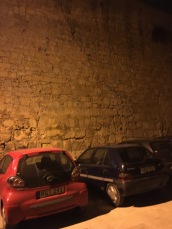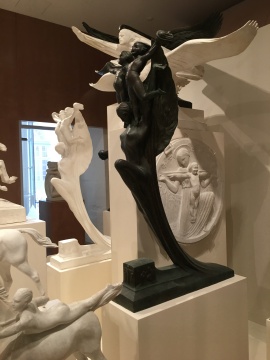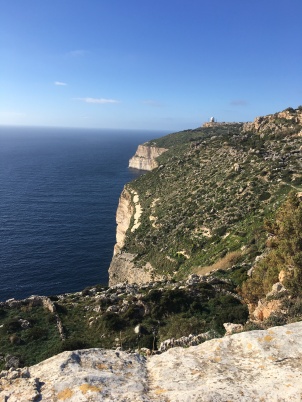 I’ve just been lucky enough to take a trip to Malta, land of my grandfather’s birth and burying place of other in-law relatives. It’s not an easy place to get to, but my heart has wanted to go there for years. It’s the fabulous history. Millenia of history. Footprints of travellers from centuries back. The sense of struggle and growth and religious wars. Cool stuff.
I’ve just been lucky enough to take a trip to Malta, land of my grandfather’s birth and burying place of other in-law relatives. It’s not an easy place to get to, but my heart has wanted to go there for years. It’s the fabulous history. Millenia of history. Footprints of travellers from centuries back. The sense of struggle and growth and religious wars. Cool stuff.
Kind son and his lovely partner arranged to take me and led me through hundreds of streets and pathways. I can’t thank them enough. It was a fabulous experience.
It’s an interesting spot. There ARE saints on every building corner. No one seems to notice them. The buildings in Valletta and Birgu are astonishingly attractive, their golden limestone sides glowing in the sun. They are also largely vacant.
Apparently Valletta has been on the downturn for some time- the buildings were wrecks until it was declared a UNESCO international treasure in 2018- lifting the tourism industry and helping with renovations. Some of the four-story buildings have coffee shops and unbelievably tiny shops in them. There are virtually no grocery stores. There ARE pharmacies. And balconies.
And tourists, even in this dead mid-winter time.
Culturally, it’s an odd place, too- people seem to come and be swept away. Prehistoric temples abound- but the people from that time mysteriously died out. The Phoenicians arrived and created art…but left. Muslims conquered through (and have been wiped off the history), and then the Knights of St John essentially built the Valletta seen today, and as far as I can tell, nothing much has happened since then. It’s all been about maintenance.
The knights were very ornamental – to the right you can see the interior of St. John’s co-cathedral, decorated on every flat surface. Even the floor is ornate, covered with decorative memorial slabs. It’s spectacular.
 Earthquakes have shaken the place- half of the former capital of Mdina was shaken to the ground- original buildings are medieval style, rebuilding is Baroque. To the right, you can see the line along a wall where the medieval crumbled away, the right side rebuilt in the Baroque era. (They rebuilt it almost exactly the same, but with Baroque fancies.) Much of Malta seems to be repairing things to be exactly as they were.
Earthquakes have shaken the place- half of the former capital of Mdina was shaken to the ground- original buildings are medieval style, rebuilding is Baroque. To the right, you can see the line along a wall where the medieval crumbled away, the right side rebuilt in the Baroque era. (They rebuilt it almost exactly the same, but with Baroque fancies.) Much of Malta seems to be repairing things to be exactly as they were.
The Maltese people have lived through invasions, the Inquisition (which apparently involved the ‘overstretching of muscles’ only and was MUCH gentler than the Spanish Inquisition), the blockades of the world wars and starvation thereof. They perch on an island made of limestone, with a thin coating of soil. Somehow they farm.
So, they’ve had a challenging time.
Now, they are having a harder one. Hidden behind the fronts of the tall houses are the Uber-rich, the 0.001%. Apartments are over 2,000,000 euros for a tiny cold space. The only real offices downtown are wealth management and investment companies. The rich hide in the tax haven, rarely seen. Do they contribute? Every museum collection and painting is labelled with the name of its sponsor, going right back to the dawn of history. Do the Uber-rich willingly pay for sewer and electrical systems when their names cannot be attached?
The rest of the island seems to rely on tourism only for support, and tourism is a fickle thing…and it doesn’t pay enough for people to live in the places they show to tourists.

Church seems scandalized
Music isn’t as present as I would have thought. We wandered over a large part of the main island and heard only top of the charts from the 1980s – except for in one very funky coffee bar down near the waterfront. In one extremely posh restaurant, we ate our dinner to a selection of bad covers of North American 80s tunes. You haven’t lived until you’ve heard YMCA sung as a ballad. Or “Killing me Softly” as an upbeat tune. It
 broke my heart a bit, local music being one of the things I like best about travel.
broke my heart a bit, local music being one of the things I like best about travel.
Instead I listened to the language, a marvellous river of Maltese, English, Arabic, Italian, all swirling around, mingling even in the same sentence. It was fascinating, and loud.
Art in Valletta seems focused on the past, even in the new art gallery, Muza. As with

Antonio Sciortino’s flowing sculptures
much of Valletta, the new museum was built within the framework of a baroque building. This is charming, and makes every museum visit interesting on many levels, but it means little conveniences like elevators, accessible washrooms, etc. are missing.
Of course, there is so much art – temples inscribed in the many years BC, decorated pots and crypts and walls and floors and sculptures on every corner by city by-law. Saints are hung by every house door.

sculptor unknown
The new artists seem to choose ancient subjects – religious paintings are prevalent. Sculptures, though new, reflect ancient events. The most recent images seem to be of the terror of WW2 (well, except the mandatory prime ministerial statues. One wonders what they will do with the latest PM, escorted in shame from the country).
Of course, they know what sells. It is a tourist destination, after all, and people come to see the saints on every corner, enjoy the buttery sun on the beaches and the buildings, taste the rabbit that is on every menu. (It’s good!) But it has the air of a country frozen solidly in time. It’s beautiful, but, like the women climbing through the cobblestone streets in stiletto heels, Malta seems to be teetering on the edge.

They got a lot of tourist during the winter since it is an easy get away from the darkness of northern europe.
LikeLike